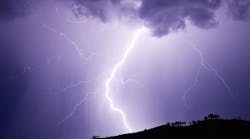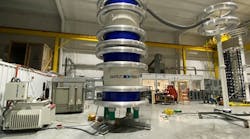For electric utilities, this is the season of more frequent lightning-induced power outages. Lightning arresters are the first line of defense against surge-related problems, however, alarming field metrics from Exacter, Inc. are showing that a high percentage (up to 40% in the southeast) of lightning arresters have either failed or deteriorated in performance, and most of these show no visual or heat signature indication of damage.
The impact of these "disconnect protection devices" with unidentified problems is huge. Statistics show that 20% of all power outages (more than 372,000 annually in the U.S.) occur because lightning arresters had failed prior to the lightning strike. What makes this problem significant is that when an arrester fails, the equipment it was supposed to protect is damaged.
To help utilities address the problem this year, Exacter, Inc. is streamlining the process of discovering these deteriorated arresters by providing a new fault-identification survey, known as the Lightning Arrester Verification Program.
"In a matter of four weeks, we will assess the condition of the utility's surge arresters. Our patented technology will identify the lightning arresters with leaking current," states John Lauletta CEO of Exacter, Inc a leading provider of grid analytics and outage-avoidance data to the utility industry. "Then, each problematic arrester is further inspected to verify the presence of leaking current and photographed to assist replacement. When the survey is completed, we deliver maps, GIS data, and spreadsheet showing locations, spatial coordinates, and pole numbers of the problem arresters."
The Lightning Arrester Verification Program from Exacter, Inc. is unique because it can provide a verification check of arresters over a large area in a matter of several weeks – including an actionable punch list of equipment for replacement.
"We provide the 40,000 ft view of where the problems are," continued Lauletta. "While we will identify a comprehensive list of faulty arresters, we often recommend a strategy of targeting components on key circuits near reclosers, substations, and commercial/industrial locations that will have the biggest impact on overall reliability. This approach is more cost-effective and allows the utility to deploy its field resources to the most important targets."
"Lightning arresters are unique among overhead line components in that it is almost impossible to detect problems," states Lauletta, "Often with problematic arresters there are no visual signs of failure, or even the presence of heat that could be detected by IR cameras."
The fact is that unless there is a heavy load on the line, a failed lightning arrester will not emit significant amounts of heat. In work done by The Ohio State University High Voltage Laboratory; researchers have identified partial discharge emissions to be the most consistent, telltale sign of an arrester that should be replaced.
There are companies that make arrester test devices and ultrasonic dishes for the identification leaking current, but these technologies have proved impractical for utilities because they must inspect and test each arrester on the system individually. With the large number arresters deployed to protect the grid, it becomes a very time and labor-intensive challenge – outside the bounds of normal maintenance or testing practices of most utilities.
The unique ability to quickly and accurately assess grid health is bringing "Exacter Field Data and Analytics" into many reliability improvement discussions domestically and internationally.
Since 2007, Exacter has surveyed millions of utility poles for more than 100 utilities. Their field-proven process is highly accurate for identifying equipment in deteriorated or weakened condition.
"The statistics don't lie. There are a significant percentage of the utility industry's lightning arresters in failed condition. With an aging distribution infrastructure, the problem is only going to get worse," concluded Lauletta. "By shoring up a utilities defense shield, you minimize collateral equipment damage from lightning strikes. This is a strategic plan utilities can channel resources into that will be evident after this spring's storm season."


